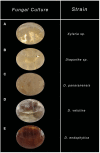Evaluation of the Antibacterial Activity of Crude Extracts Obtained From Cultivation of Native Endophytic Fungi Belonging to a Tropical Montane Rainforest in Colombia
- PMID: 34603244
- PMCID: PMC8485978
- DOI: 10.3389/fmicb.2021.716523
Evaluation of the Antibacterial Activity of Crude Extracts Obtained From Cultivation of Native Endophytic Fungi Belonging to a Tropical Montane Rainforest in Colombia
Abstract
Bioactive secondary metabolite production from endophytic fungi has gained a recurring research focus in recent decades as these microorganisms represent an unexplored biological niche for their diverse biotechnological potential. Despite this focus, studies involving tropical endophytes remain scarce, particularly those isolated from medicinal plants of these ecosystems. In addition, the state of the art of the pharmaceutical industry has experienced stagnation in the past 30years, which has pushed pathogenic infections to get one step ahead, resulting in the development of resistance to existing treatments. Here, five fungal endophytes were isolated from the medicinal plant Otoba gracilipes (Myristicaceae), which corresponded to the genera Xylaria and Diaporthe, and screened to demonstrate the promissory potential of these microorganisms for producing bioactive secondary metabolites with broad-spectrum antibacterial activities. Thus, the evaluation of crude organic extracts obtained from the mycelia and exhaust medium allowed the elucidation of Xylaria sp. and Diaporthe endophytica potential toward providing crude extracellular extracts with promising bioactivities against reference strains of Escherichia coli (ATCC 25922) and Staphylococcus aureus (ATCC 25923), according to the determined half-maximum inhibitory concentration (IC50) with values down to 3.91 and 10.50mg/ml against each pathogen, respectively. Follow-up studies provided insights into the polarity nature of bioactive compounds in the crude extracts through bioactivity guided fractionation using a polymeric resin absorbent alternative extraction procedure. In addition, evaluation of the co-culturing methods demonstrated how this strategy can enhance endophytes biosynthetic capacity and improve their antibacterial potential with a 10-fold decrease in the IC50 values against both pathogens compared to the obtained values in the preliminary evaluations of Xylaria sp. and D. endophytica crude extracts. These results support the potential of Colombian native biodiversity to provide new approaches concerning the global emergence of antibiotics resistance and future production of undiscovered compounds different from the currently used antibiotics classes and simultaneously call for the value of preserving native habitats due to their promising ecosystemic applications in the biotechnological and pharmaceutical industries.
Keywords: Rainforest ecosystem; antibacterial activity; co-culturing strategies; fungal endophytes; secondary metabolites.
Copyright © 2021 Charria-Girón, Espinosa, Zapata-Montoya, Méndez, Caicedo, Dávalos, Ferro, Vasco-Palacios and Caicedo.
Conflict of interest statement
The authors declare that the research was conducted in the absence of any commercial or financial relationships that could be construed as a potential conflict of interest.
Figures








References
-
- Bertrand S., Schumpp O., Bohni N., Bujard A., Azzollini A., Monod M., et al. . (2013). Detection of metabolite induction in fungal co-cultures on solid media by high-throughput differential ultra-high pressure liquid chromatography-time-of-flight mass spectrometry fingerprinting. J. Chromatogr. A 1292, 219–228. doi: 10.1016/j.chroma.2013.01.098, PMID: - DOI - PubMed
-
- Brakhage A. A., Schuemann J., Bergmann S., Scherlach K., Schroeckh V., Hertweck C. (2008). “Activation of fungal silent gene clusters: a new avenue to drug discovery,” in Natural Compounds as Drugs, eds. Petersen F., Amstutz R. 1–12. - PubMed
LinkOut - more resources
Full Text Sources
Molecular Biology Databases
Miscellaneous

